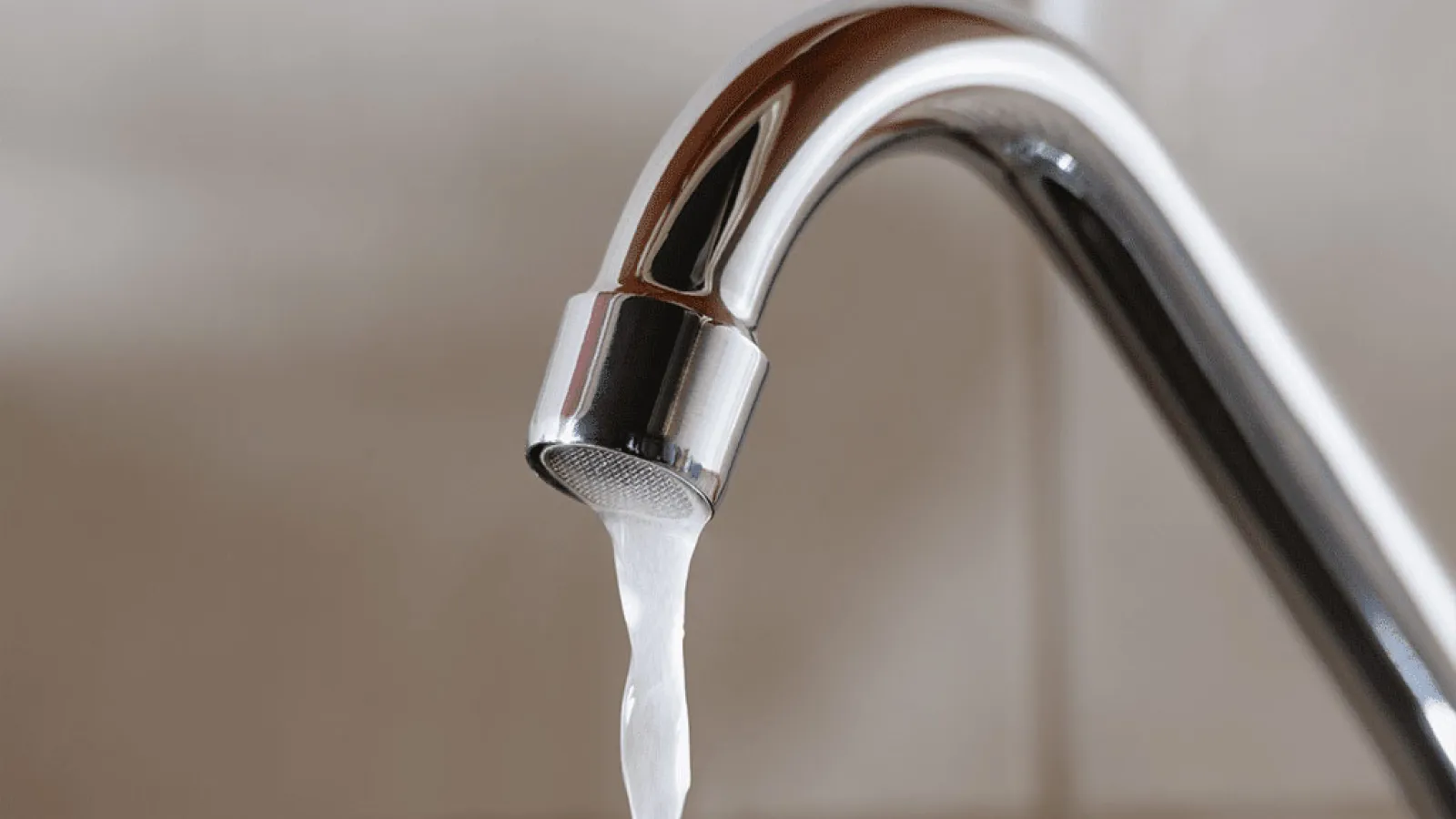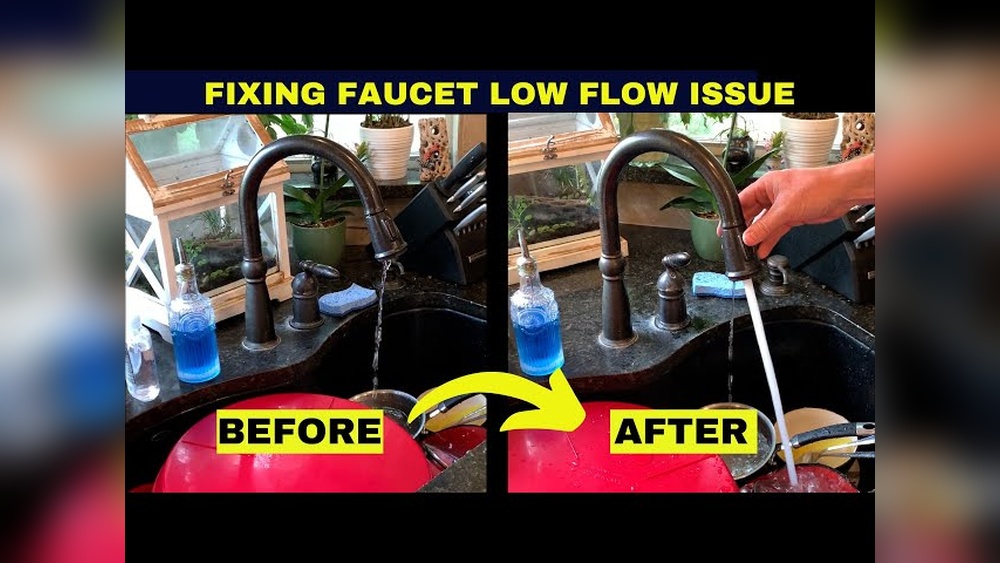Is your kitchen faucet struggling with low water pressure? It’s frustrating when you turn on the tap expecting a steady flow, only to get a weak trickle instead.
You might wonder, “Why is my kitchen faucet water pressure low? ” The good news is, you don’t have to live with this problem or immediately call a plumber. Often, the cause is something simple that you can fix yourself.
You’ll discover the most common reasons behind low water pressure in your kitchen faucet and easy steps you can take to restore that strong, satisfying flow. Keep reading, and you’ll have your faucet working like new in no time.

Credit: www.estesair.com
Check Hot And Cold Water Pressure
Checking the hot and cold water pressure is a key step in finding why your kitchen faucet has low water flow. This helps narrow down the problem to either one or both water lines.
Low pressure in both lines often points to a clogged aerator or faucet cartridge. If just one line is affected, the issue is likely within that supply line or valve.
Test Both Water Lines
Turn on the hot water fully and watch the flow. Then do the same for the cold water. Compare the pressure from both lines.
If both lines have low pressure, the faucet parts might be blocked. If only one line is weak, the problem is in that specific supply line.
Identify Affected Line
Turn off the water supply valves under the sink. Remove the aerator from the faucet tip carefully. Clean it with a brush to remove debris.
Check the supply lines and valves for blockages or damage. Fix or replace parts if needed to restore proper water flow.

Credit: www.youtube.com
Clean The Faucet Aerator
Cleaning the faucet aerator can improve your kitchen faucet’s water pressure. Over time, tiny mineral deposits and debris build up inside the aerator. This buildup blocks water flow and lowers pressure. Removing and cleaning the aerator often restores strong water flow quickly. The process is simple and requires only a few steps.
Turn Off Water Supply
Start by turning off the water supply to the faucet. Look under the sink for the shutoff valves. Turn them clockwise to close and stop water flow. This step prevents water from spraying when you remove the aerator.
Remove And Disassemble Aerator
Unscrew the aerator from the faucet tip by turning it counterclockwise. Use pliers if it’s tight, but wrap the aerator with a cloth first. This protects the faucet’s finish from scratches. Take the aerator apart carefully to access all parts inside.
Soak In Vinegar Overnight
Place the aerator parts in a bowl filled with white vinegar. Let them soak overnight. Vinegar dissolves mineral deposits and loosens debris. This natural cleaning method is safe and effective. After soaking, the aerator will be free of most blockages.
Rinse And Reassemble Aerator
Rinse all aerator parts with clean water to remove loosened debris and vinegar. Use a soft brush to scrub any remaining buildup. Once clean, reassemble the aerator pieces carefully. Screw the aerator back onto the faucet tightly but avoid overtightening. Turn on the water supply and check the pressure.
Inspect Supply Valves And Lines
Inspecting the supply valves and lines is a key step to fix low water pressure in your kitchen faucet. These parts control water flow to your faucet. Problems here can block or reduce water delivery. Checking them helps find and solve pressure issues quickly.
Ensure Valves Are Fully Open
Supply valves under the sink control water flow to your faucet. Sometimes, these valves are only partially open. This reduces water pressure. Turn the valves counterclockwise to fully open them. Check if water pressure improves after opening the valves completely.
Check For Kinks Or Damage
Supply lines connect the valves to the faucet. These lines can get bent or damaged. Kinks block water flow and lower pressure. Look closely for bends, cracks, or leaks. Replace any damaged supply lines to restore normal water pressure.
Flush Supply Lines
Mineral deposits and debris can build up inside supply lines. This buildup blocks water flow. Turn off the supply valves and disconnect the lines. Flush them with water to clear out any blockages. Reconnect the lines and open the valves to test pressure again.
Replace Or Clean Faucet Cartridge
Low water pressure from your kitchen faucet often points to problems inside the faucet itself. The faucet cartridge controls water flow and temperature by mixing hot and cold water. Over time, cartridges can get clogged with mineral deposits or wear out, restricting water flow. Cleaning or replacing the cartridge can restore strong water pressure quickly.
Cartridge maintenance is a simple fix many homeowners can try before calling a professional. Removing the cartridge lets you check for blockages or damage. If cleaning does not improve water flow, replacing the cartridge is the next step. This part is affordable and widely available at hardware stores.
Recognize Cartridge Issues
Signs of cartridge problems include uneven water flow or difficulty adjusting temperature. A cartridge stuck in one position can cause low water pressure or only hot or cold water to run. Mineral buildup inside the cartridge often reduces flow. If water pressure drops suddenly after years of use, the cartridge likely needs attention.
To check the cartridge, turn off water supply valves under the sink. Remove the faucet handle and access the cartridge by unscrewing the retaining nut. Look for debris or damage. Soaking the cartridge in vinegar can dissolve mineral deposits. If it looks worn or cleaning does not help, replace it.
When To Call A Plumber
Cartridge cleaning or replacement solves most faucet pressure problems. Call a plumber if the faucet still has low pressure after these steps. Plumbing issues like pipe blockages or valve problems may cause pressure drops. A professional can diagnose and fix hidden plumbing faults safely.
Contact a plumber if water leaks appear during cartridge replacement. Also, seek help if you cannot remove the cartridge or reassemble the faucet properly. A plumber’s tools and experience ensure the job is done right without damage.
Address Complex Plumbing Issues
Low water pressure in your kitchen faucet can stem from complex plumbing issues. These problems often hide deeper inside your home’s plumbing system. Understanding these causes helps you decide the right fix. Some issues require professional help to restore proper water flow.
Corroded Pipes
Corrosion inside pipes narrows water flow. Rust builds up over time and clogs the pipes. This reduces water pressure noticeably at the faucet. Older homes with metal pipes face this problem often. Replacing corroded pipes improves water pressure and water quality. A plumber can inspect and recommend the best solution.
Faulty Pressure Regulator
The pressure regulator controls water pressure entering your home. If it malfunctions, water pressure drops at faucets. A damaged regulator cannot maintain steady pressure. This causes inconsistent or low water flow. Testing and replacing a faulty regulator restores proper pressure. Only a trained plumber should handle this task for safety.

Credit: www.reddit.com
Frequently Asked Questions
How Do I Fix Low Water Pressure In My Kitchen Faucet?
Check if both hot and cold water have low pressure. Clean or replace the faucet aerator. Ensure supply valves are fully open. Inspect and flush supply lines for blockages. Replace the faucet cartridge if needed. Call a plumber for complex plumbing issues.
What Causes Low Water Pressure In Only One Faucet?
Low water pressure in one faucet often results from a clogged aerator, partially closed valve, or a blocked supply line. Check and fully open supply valves, inspect for kinks, and clean or replace the aerator and cartridge to restore proper flow.
Why Is My Hot Water Pressure Low But My Cold Is Fine?
Low hot water pressure usually results from clogged valves, mineral buildup in the hot water line, or partially closed supply valves. Cold water pressure stays fine because its line remains clear and fully open. Check and clean the hot water valve, supply line, and faucet aerator to fix the issue.
Why Is My Water Pressure So Low But No Leak?
Low water pressure without leaks often results from clogged aerators, partially closed valves, or blocked supply lines. Check and clean the faucet aerator, ensure valves are fully open, and inspect supply lines for kinks or debris. Replace the faucet cartridge if needed.
Conclusion
Low water pressure in your kitchen faucet often has simple causes. Checking both hot and cold lines helps spot the problem. Cleaning the aerator usually clears mineral buildup and debris. Make sure supply valves under the sink are fully open.
Sometimes, faucet cartridges get clogged and need replacement. If basic fixes fail, a plumber can find hidden plumbing issues. Regular maintenance keeps water flowing strong and steady. Don’t ignore low pressure—it affects daily kitchen tasks. Act early to restore your faucet’s good water flow.

